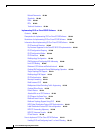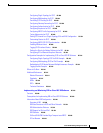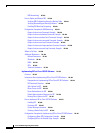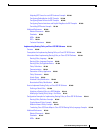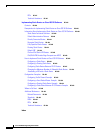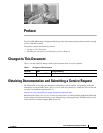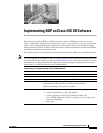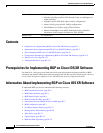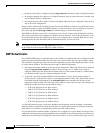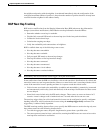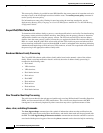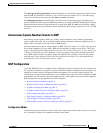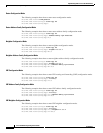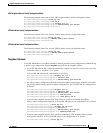
Implementing BGP on Cisco IOS XR Software
Contents
RC-2
Cisco IOS XR Routing Configuration Guide
OL-14356-01
Contents
• Prerequisites for Implementing BGP on Cisco IOS XR Software, page RC-2
• Information About Implementing BGP on Cisco IOS XR Software, page RC-2
• How to Implement BGP on Cisco IOS XR Software, page RC-42
• Configuration Examples for Implementing BGP on Cisco IOS XR Software, page RC-127
• Where to Go Next, page RC-132
• Additional References, page RC-133
Prerequisites for Implementing BGP on Cisco IOS XR Software
You must be in a user group associated with a task group that includes the proper task IDs for BGP
commands. For detailed information about user groups and task IDs, see the Configuring AAA Services
on Cisco IOS XR Software module of Cisco IOS XR System Security Configuration Guide.
Information About Implementing BGP on Cisco IOS XR Software
To implement BGP, you need to understand the following concepts:
• BGP Functional Overview, page RC-3
• BGP Router Identifier, page RC-3
• BGP Default Limits, page RC-4
• BGP Next Hop Tracking, page RC-5
• Autonomous System Number Formats in BGP, page RC-7
• BGP Configuration, page RC-7
• No Default Address Family, page RC-19
• Routing Policy Enforcement, page RC-20
• Table Policy, page RC-21
• Update Groups, page RC-22
• BGP Best Path Algorithm, page RC-27
Release 3.5.0 The following features were supported:
• IPv6 Provider Edge and IPv6 VPN Provider Edge over Multiprotocol
Label Switching
• Neighbor-specific VRF IPv6 address family configurations
• Address family group-specific VPNv6 configurations
• VPN4/VPNv6 over IP Core using L2TPv3 Tunnels
• Multicast Distribution Tree (MDT) Subaddress Family Identifier
Information (SAFI) support for Multicast VPN (MVPN)
Release 3.6.0 No modification.



